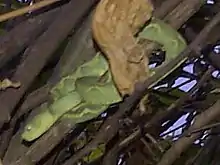| Atheris rungweensis | |
|---|---|
 | |
| Scientific classification | |
| Domain: | Eukaryota |
| Kingdom: | Animalia |
| Phylum: | Chordata |
| Class: | Reptilia |
| Order: | Squamata |
| Suborder: | Serpentes |
| Family: | Viperidae |
| Genus: | Atheris |
| Species: | A. rungweensis |
| Binomial name | |
| Atheris rungweensis | |
| Synonyms[2] | |
| |
Atheris rungweensis, commonly known as the Rungwe tree viper,[3][4] Mt Rungwe bush viper,[2] and Rungwe leaf viper,[5] is a species of venomous viper found in East Africa.[2][3]
Taxonomy
The specific name is derived from the species type locality in the Rungwe Mountains.[1] It was formerly considered as a subspecies of Atheris nitschei.[2][6]
Description
It grows to a maximum length (body + tail) of 65 cm (26 in). At midbody, it has 22–33 dorsal scale rows. The ventral scales number 150–165, and the subcaudals 46–58.[4]
The color pattern is variable, with a ground color that ranges from bright green to green to black. Usually, this is overlaid with a pair of yellow dorsolateral zigzag lines. A row of yellow spots on the sides of the ventral scales may also be present. Specimens from the Sumbawanga region usually have a green yellow and black color pattern. Neonates are a dark brown or gray, but with a bright yellow tail tip.[6]
Distribution and habitate
Atheris rungweensis is known from scattered locations from south-western Tanzania to north-eastern Zambia and south to the Nyika Plateau in northern Malawi.[3]
Atheris rungweensis is usually found in low bushes along streams and at the edges of mountain forests at altitudes of 800–2,000 m (2,600–6,600 ft).[4][7] Occasionally, it is encountered in moist savanna, woodland, and hill forest habitats.[6]
References
- 1 2 McDiarmid RW, Campbell JA, Touré T. 1999. Snake Species of the World: A Taxonomic and Geographic Reference, Volume 1. Washington., District of Columbia: Herpetologists' League. 511 pp. ISBN 1-893777-00-6 (series). ISBN 1-893777-01-4 (volume).
- 1 2 3 4 Atheris rungweensis at the Reptarium.cz Reptile Database. Accessed 5 September 2021.
- 1 2 3 Spawls S, Branch B. 1995. The Dangerous Snakes of Africa. Ralph Curtis Books. Dubai: Oriental Press. 192 pp. ISBN 0-88359-029-8.
- 1 2 3 Mallow D, Ludwig D, Nilson G. 2003. True Vipers: Natural History and Toxinology of Old World Vipers. Malabar, Florida: Krieger Publishing Company. 359 pp. ISBN 0-89464-877-2.
- ↑ Mehrtens JM. 1987. Living Snakes of the World in Color. New York: Sterling Publishers. 480 pp. ISBN 0-8069-6460-X.
- 1 2 3 Spawls S, Howell K, Drewes R, Ashe J. 2004. A Field Guide to the Reptiles of East Africa. London: A & C Black Publishers Ltd. 543 pp. ISBN 0-7136-6817-2.
- ↑ Atheris rungweensis at The World Of Atheris. Accessed 9 September 2007.
Further reading
- Bogert CM. 1940. Herpetological Results of the Vernay Angola Expedition, with Notes on the African Reptiles in Other Collections. Part I. — Snakes, Including an Arrangement of African Colubridae. Bull. American Mus. Nat. Hist. 77: 1-107 + Plate I. ("Atheris nitschei rungweensis, new species", pp. 104–106, Figure 18).